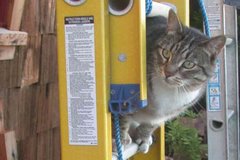The official CASEIS Cruise Blog is located here: http://www.ipgp.fr/caseis This official blog is written by my shift-mate Lola Johannes.
We embarked at about 08:00 on Sunday, 2016/05/29. The team is excited to get to sea, including me.- Here we can see that the science crew is anticipating a successful cruise. There is a ferry ship passing us on the port side, probably travelling to one of the islands to the south of Guadeloupe.
- Everyone is taking photos of the soon to be far off land and of each other.
- Here is the view from the stern as we left the port of Pointe-a-Pitre. We headed almost due south until we passed the shallow shelf. I could see regions of bright seafloor pass beneath the ship, so the water was quite clear and shallow.
- Here is a map that shows some targeted core sites. The green dots are the better choices and red are lower priority for various reasons (source isolation from land or other core site sediment sources, geomorphology, etc.). The color represents elevation in meters. Underneath the elevation data is a slopeshade map, with dark shades representing steeper slopes and lighter values representing shallower slopes. I prefer slopeshades over hillshades because hillshade maps are biased relative to the orientation of the artificial sunlight. The port of Pointe-a-Pitre is shown as a white dot and labeled "PTP."
- In a few hours we will arrive at the green dot labeled "1" and take our first core. This core will be a short core because we want to test our ability to sample the sediment without damaging the coring equipment. The coring engineers here are some of the best in the world and we have the longest piston coring device in the world. Each core section is 12 meters and the longest configuration is with 3 sections. If the sediment is too stiff, the core barrels can be bent and twisted. This happened when this "calypso" corer was used in Sumatra. So, we will first collect a 1 section core (12 m).
- Then we will wait 12 hours before we can analyze the core for the sediment to equalize in temperature. While we wait, we will conduct some geophysical exploration (multibeam sonar bathymetry, CHIRP seismic, and streamer seismic). After that, we will head for the green core labeled "2" and collect our second core. It is possible we will collect a longer core. Then more geophysical exploration. At some point, we will collect geophysical data in the deep part of the map, the subduction zone trench and collect cores, one of which is labeled "3."
- As with all coring cruises, the plans will change with our experience. I will update the core locations as we collect them and create new maps showing our intended regions of exploration.






2 comments:
Is there suggestive prior coring? Likely source area of turbidites?
No existing cores in this location, but there was CHIRP shallow seismic from earlier cruises that showed this to be a region with turbidites. The CHIRP we collected today also showed good stratigraphy.
The source area is along the slopes to the west. Based on what I saw, these turbidites appear to transport as sheet flow across the seabed, not only confined to channels. This is similar to Cascadia and Sumatra.
Post a Comment